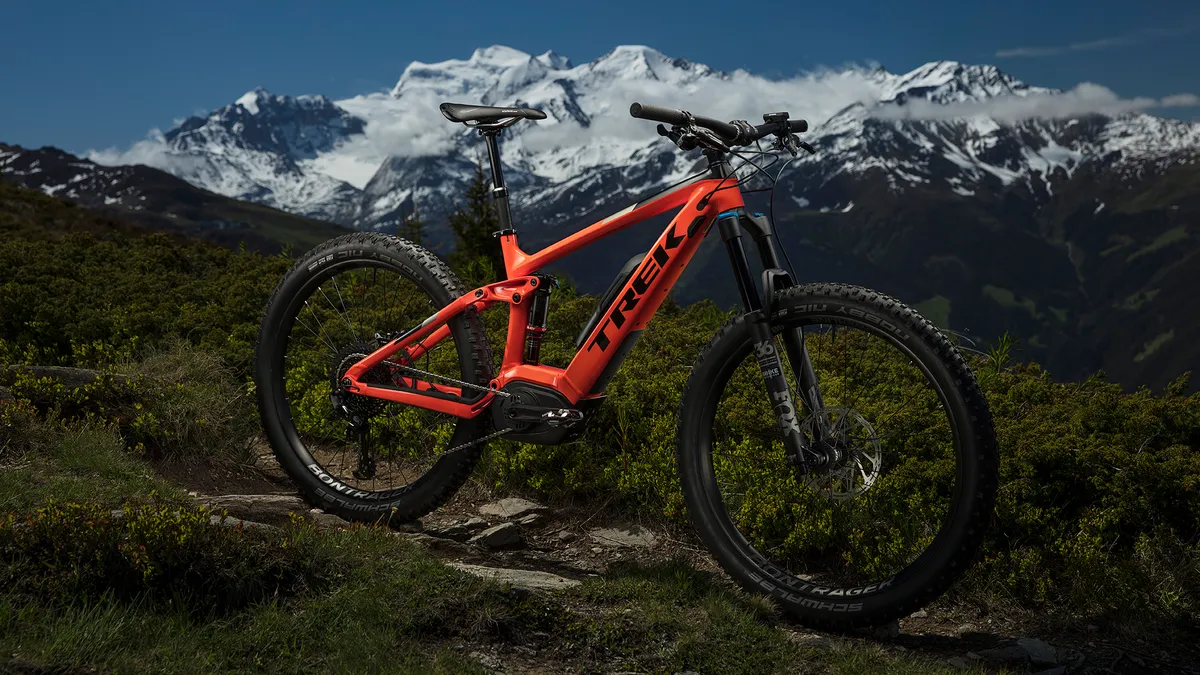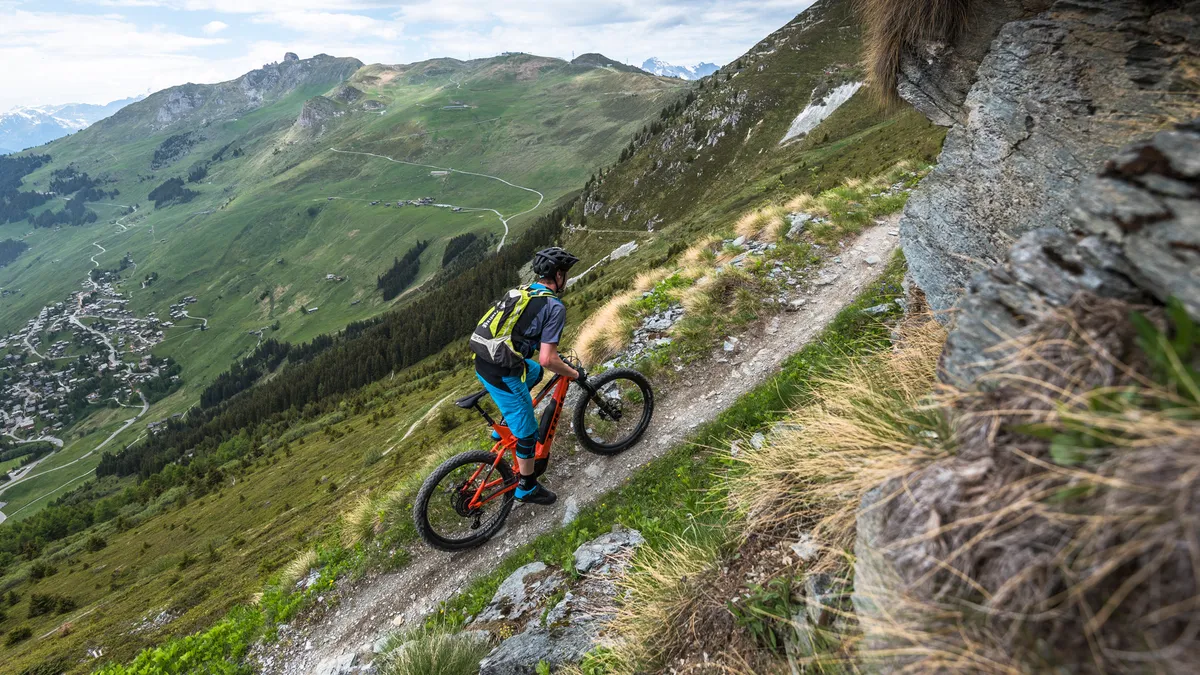Trek’s second generation Powerfly e-bike builds on the success of its predecessor but tweaks to the Bosch motor and new e-bike specific components make for an altogether more pleasing ride.
Trek Powerfly FS 9 LT spec overview
- Frame: Alpha Platinum Aluminium, ABP, EVO link, E2 tapered head tube, Knock Block, internal derailleur and dropper post routing, integrated battery, G2 Geometry, Boost148, 150 mm travel
- Motor: Bosch Performance CX, 250 watt, 75 Nm with Bosch Powerpack Performance 500 downtube battery
- Fork: Fox Performance 36 Float, GRIP adjustable damper, E2 tapered steerer, Boost110, G2 Geometry w/51 mm offset, e-bike optimised, 150 mm travel
- Rear shock: RockShox Deluxe RT3, RE:aktiv 3-position damper, tuned by Trek Suspension Lab, 205x57.5 mm
- Drivetrain: SRAM EX1, 8-speed
- Brakes: SRAM Guide RE hydraulic disc
- Wheelset: Bontrager Powerline Comp 40, 54T Rapid Drive, Tubeless Ready, Boost110 front, Boost148 rear
- Tyres: Schwalbe Nobby Nic Performance, Tubeless, 27.5x2.80in
I tested the longer travel Powerfly FS 9 LT, which is the spendiest of two longer travel models with 150mm of travel at each end. These sit alongside two shorter travel full-suspension Powerflys and several electrified Powerfly hardtails.
For 2018 there’s a new front triangle, which positions its battery lower than before yet still retains its tool-free easy access and ability to be charged while fitted to the bike. Each model now gets a 500Wh battery as standard, too.
The Powerfly boosts its rider’s efforts thanks to a 250w Bosch Performance Line CX motor and accompanying handlebar-mounted Purion control unit. New for 2018 is Bosch’s e-mtb motor mode, which has been developed as a set and forget mode for those who don’t wish to flick through the bike’s four assistance settings.
This new setting automatically shifts between the assistance usually offered between existing Tour to Turbo modes depending on the torque it reads from its riders input. It’s also said to save on battery power.

Trek’s concentric pivot ABP suspension system remains, and so does the simple yet effective Mini Link feature – a flippable chip at the seatstay that offers +/0.5 degrees at the head angle and +/- 5mm at the bottom bracket.
The 9 LT also sports Trek’s proprietary RE:aktiv shock, which uses regressive valving and aims to provide support against pedaling forces and g-outs but remain sensitive to even the smallest of impacts.
Rotating at each Boost axle is an all-new wheelset configured specifically to deal with the extra heft of a bike such as this one. The new Powerline plus-size wheels use 32 hole rims with thicker sidewall rims that are built to downhill standards. These replace the thinner rims that dinged relatively easily on the last Powerfly.
In a similar vein, Trek has opted for an e-bike specific Fox 34, with thicker stanchions and lowers compared to a regular 34 in order to support the higher loads and forces found encountered with these weightier bikes. SRAM’s excellent 8-speed EX1 drivetrain s has also been carried over from last year’s model.
The brakes are also e-bike specific, namely SRAM’s Guide REs which mate the four piston calipers from the company’s Code gravity brakes to the familiar Guide levers.
Stable and supportive ride from all but its tyres
A full day on the loose, steep and rocky trails of Verbier formed an ideal playing ground for the Powerfly, and our route was one that would’ve proved vicious for most mere mortals without the assistance of a motor.
I was encouraged to try the bike using Bosch’s latest e-mtb mode, which dished out power intelligently depending on what I was doing with my legs.I found this worked well most of the time but I did switch down to tour/eco modes for technical sections, where I found the e-mtb mode would give a little too much gogo juice.
Talking of juice, our Powerfly drained itself of a majority of its charge within 35km. That doesn’t sound like a huge number but when you consider the 1,800+ metres of climbing and stop/start nature of our ride I feel it represents quite extreme usage.

With a leg over the Powerfly you may need to recalibrate your sense of what you can now climb. This is by no means something that is unique to the Powerfly, but is something true of most electric mountain bikes. By centering my weight, shifting down a cog and raising my cadence I could winch up steep climbs that my legs alone simply wouldn’t carry me up.
The frame’s 475mm chainstays are a byproduct of Bosch’s lengthy motor yet they do bring benefits of their own. The bike climbs exceptionally, for example, and the additional length at the rear triangle no doubt contributes to the high levels of stability this chassis provides. The flipside of these stays is that low speed switchback climbs require careful power management and body positioning to avoid embarrassing understeer moments. It’s a trade-off I was more than happy to ride around.

The rest of the geometry is pretty sorted, too, with a 66 degree head angle (in the low setting) and a 478mm reach figure for the size 21.5in bike I was riding. I swapped out the standard fit 60mm stem for a 40mm part which played perfectly with the Powerfly’s 750mm handlebars but did rob me of some important room, which was certainly noticeable on the climbs. Some of this was probably down to the slackish 71.5 degree seat angle, though.
I found that the plus-sized footprint of the Powerfly – with its 2.8in Schwalbe Nobby Nic tyres – provided ample grip across a wide range of surface, but they do squirm when you push hard and generally feel a bit vague for those who are used to tyres with a stiffer sidewall.
This is in contrast to the e-bike specific Fox fork and Rockshox Deluxe RT3 Re;Aktiv damper, which both provide a balanced and supportive tune that refused to be flustered.
I think it’s fair to say that both grip and stability levels are nearing that of what you’d normally find on a well configured downhill bike
Abundant grip levels and extra bulk make for a bike that would rather stay on the ground, but pushing harder found the Powerfly will leap with surprising grace should you want to get airborne. I think it’s fair to say that both grip and stability levels are nearing that of what you’d normally find on a well configured downhill bike.

It’s important to shut the assistance off when things point steeply down, though, because not doing so and getting a crank in where you’d normally do so on an unassisted bike can lead to a whole new world of sketchiness. Trust me, I stacked it while doing so.
SRAM’s EX1 deserves plenty of praise, too. Its smooth, one-click-at-a time action feeds the next gear in a way that simply doesn’t happen with a regular drivetrain. There’s none of the nasty chain pinging, cassette snatching issues that e-bikes with regular drivetrains often exhibit. Also from SRAM are the Guide RE brakes, which provide the same powerful and controlled braking that we’ve come to expect from the brand.
My takeaway is that this new, more capable Powerfly can make its own fun where you’d normally be hurting, and its stability on descents means you needn’t miss out on more technical downhills, either.
Its sheer thirst for mileage means it’s perfect for the adventurer who wants to run their own uplift, and if that’s your bag then I reckon there are very few tools that will do the job better.




